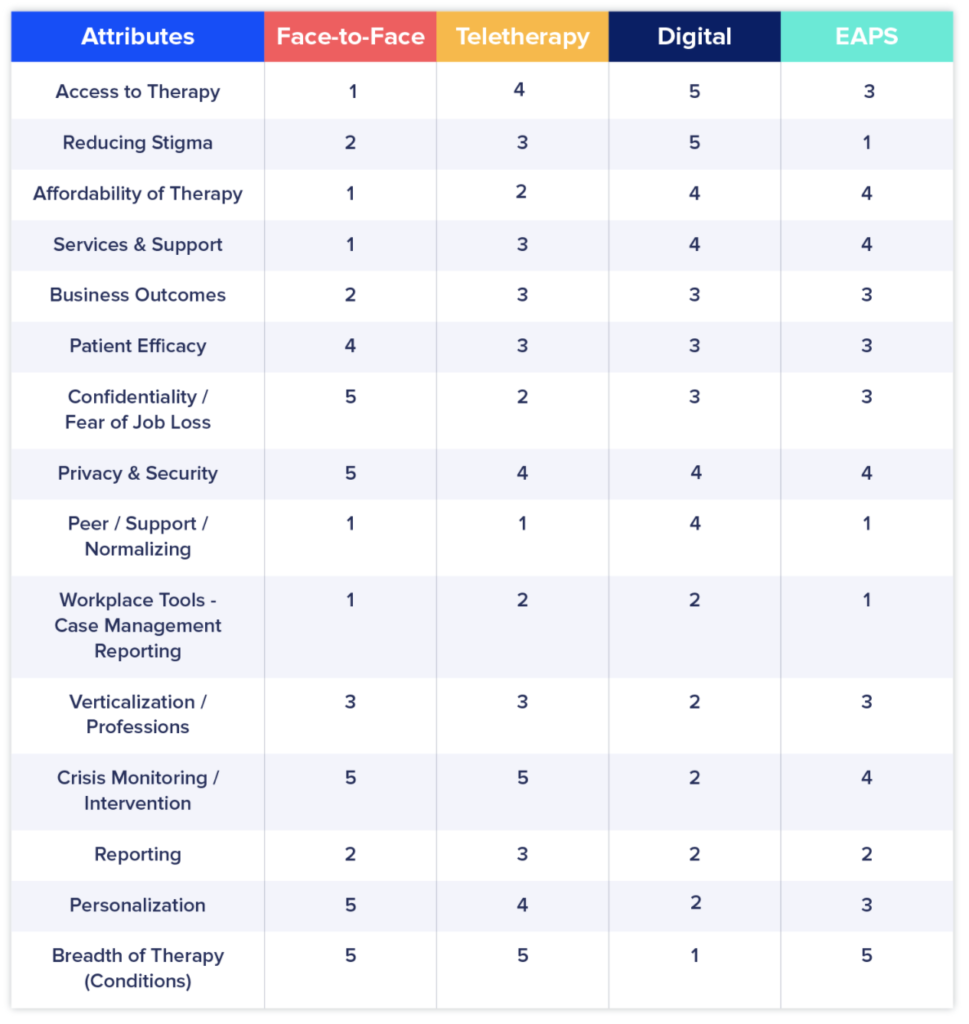It may sound easy, but for many organizations, this simple change in how you view your mental health program makes it easier and faster to drive better outcomes for your workforce, and reduce the cost of mental health for your organization.
As the cost of mental health continues to skyrocket, organizations are struggling to find sustainable solutions for delivering mental health to employees at scale. Chief among these problems:
- Increases in employee absence/on-leave and costs due to work-related stressors
- Delays and barriers to access for treatment due to stigma and shortages in therapists
- Wide variance in outcomes and lack of options to solve problems in a sustainable way
We encourage organizations that want a fast and sustainable path out of the status quo to begin to view their mental health program as a kind of ecosystem within the overall health strategy.
That is, to aim to provide a collection of interacting mental health components that complement one another and drive more value together than any one component can deliver on its own.
Specifically, this means considering how face-to-face, teletherapy, EAPs/EFAPs and online CBT solutions can be made available to employees as a combined offering.
For most organizations, taking this approach will enhance their existing mental health program and remove the greatest barriers to employee mental health and wellbeing.
There are several reasons why this is an appealing strategy:
- Lower Cost: Augmenting your existing wellness programs with new digital platforms is a cost-effective way to engage and support a diverse mix of employees. Dollar for dollar, adding an online CBT is hands-down the least expensive way to make mental health treatment accessible to an entire workforce at scale.
- Simple & Non-disruptive: Compatible improvements are non-disruptive. Rather than dismantle what’s already in place, adding an online CBT program to your existing employee mental health services extends your reach to employees who aren’t using face-to-face, teletherapy, or their EAPs.
- Higher Quality of Care and Outcomes: A modular approach creates a “solution stack” of therapy types that, when combined, deliver greater overall value. This modular or “stack” approach is a modern way of creating an ecosystem that creates integration opportunities that drive greater value and better overall mental health outcomes.
Combining Mental Health Services Creates a More Effective Mental Health Ecosystem
Each of the different mental health services brings its own unique value to an organization’s mental health program.
- Face-to-face CBT is an effective solution for employees who need high-touch, specialized mental health or who may be struggling with comorbidity conditions. The greatest limitations to face-to-face therapy treatment are the cost and sessions available under company policies.
- Teletherapy can be helpful in making the benefits of individual attention from a therapist available remotely, without the limiting factor of having to travel to a therapist’s office. There are limits to how many sessions are available to employees.
- EAPs/EFAPs are part of the ecosystem of mental health, as a vehicle through which employees can access various therapies including (primarily) face-to-face and teletherapy. The structured nature of EAP/EFAP programs helps with organization and management, but can introduce limitations to the therapy experience. For example, employees have to self-identify as the first step in accessing the services, which creates a stigma that often keeps utilization rates low (average 10%). There are also limits to the maximum number of allowed therapy sessions, and depth of services offered due to its low-cost.
- Online CBT makes CBT modules accessible by anyone from a mobile phone, tablet or computer. This completely eliminates the need for having to schedule sessions, especially when therapists aren’t available or far away. A digital platform like Starling Minds offers unlimited sessions and access to their module sessions, thus removing the greatest barriers to employee mental health including access, cost, and shortages in high-quality mental healthcare. Although, digital platforms often do not provide individualized sessions like face-to-face or teletherapy options.
Thus, it’s in the combination of these mental health services that organizations can begin to truly deliver support across the entire spectrum of mental health and create better experiences for employees.
As an example, the limiting factors of physical location, scheduling time off work and therapist availability create stressors on a workplace mental health management in the form of wait times. Delays in beginning treatment cause other risk factors to go up. While an employee waits for a session, their symptoms or condition can get worse.
During the waiting period, the risk of leave increases, and this has a cascading negative effect on the company in the form of disruption to fellow employees and managers. As symptoms worsen, more employees find themselves in need of leave. Case management volumes and costs increase, adding more stress to an already overtaxed system.
Imagine, however, being able to provide employees with access to online CBT while they’re waiting for their face-to-face therapy session. Online CBT can be used to help employees build their mental health literacy in advance. This tends to help employees feel more empowered and prepared and increases the likelihood of having a more constructive session with a face-to-face therapist.
What’s more, online CBT is an excellent early intervention solution, a key to reducing mental health costs. Making online CBT modules accessible to employees at the onset of symptoms is proven to greatly reduce the caseload of employees requiring face-to-face therapy and leave.
An Approach Everyone Can Agree On
It’s easy to see how combining mental health support creates outcomes that are greater than the sum of individual parts. A holistic ecosystem of combined support delivers benefits throughout the organization. For example:
HR and Employee Experience
- Providing CBT education in a modern digital platform that is accessible by anyone at any time eliminates barriers and stigmas. It helps HR professionals and People leaders demonstrate to employees that the organization values mental and overall health.
- A healthier workforce also improves morale, team collaboration, job satisfaction, performance, retention, all of which contribute to reduced turnover and training costs.
Occupational Health / Safety
- Access to mental healthcare at the onset of symptoms helps employees develop skills for coping with workplace stressors. This creates a workforce that feels empowered and in control of their mental health.
- Access to mental healthcare when it’s needed helps prevent the worsening of symptoms. This provides a more proactive strategy for mental health that many organizations want to offer but struggle to deliver and implement.
- Engaging online CBT content that’s accessible from mobile devices tends to be eagerly consumed by employees, meaning adoption and utilization rates improve.
Disability Case Managers
- When employees can self-serve for mental healthcare on their own, there are no barriers to early access. As more employees learn skills for coping with workplace stressors early on, the need for absenteeism and leaves is lowered, lessening the high case load burden for case managers.
- Online CBT can also promote earlier return-to-work as treatment is not dependent upon in-person module sessions with gaps between sessions.
- With a combined complement of services, disability management teams can finally be released from the burden and strain of having nothing to offer employees should their claims be denied all together.
Organizational Leaders
- Cost-effective online CBT programs can greatly reduce the cost and duration of claims, which many organizations find to be a staggering cost within their mental health program.
- Reduction in workplace disruptions caused by workers on leave, absenteeism and presenteeism helps organizations achieve greater business outcomes in the form of higher productivity in their workforce.
Components of an Employee Mental Health Ecosystem
The chart illustrates how face-to-face, teletherapy, online CBT, and EAPs allows you to deliver a more enhanced and complete solution for employee mental health.
For each of the attributes, note the value score that is delivered by your current mental health services, and see where other services can be added to deliver greater value.

Everyone benefits when your existing mental health program no longer has to ‘carry the day’ as the be all and end all solution.
Adding an online CBT program to your existing mental health program is a proven way to drive better mental health outcomes for your employees, and better business outcomes for your organization.
It is seen by more and more organizations as the lifeline employees need in today’s busy workplace.
Making it happen is easier than you think.
Contact us today to learn if Starling Minds is the missing piece your employee health strategies needs.




